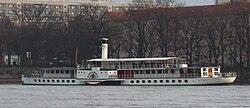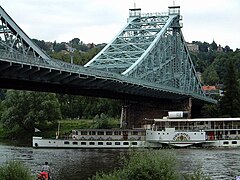Dresden (ship, 1926)
|
Paddle steamer Dresden on the Terrassenufer below the Albert Bridge
|
||||||||||||||||||
|
||||||||||||||||||
|
||||||||||||||||||
|
||||||||||||||||||
|
||||||||||||||||||
The passenger steamer Dresden is the flagship of the Saxon steamship and the sister ship of the Leipzig . Both ships are the largest paddle steamers in the fleet. It was laid down with hull number 60 . It is the third ship to bear this name. Since 1992 it belongs to the existence of the Saxon Steamship GmbH & Co. KG Conti Elbschiffahrts and travels to the upper same . Home port are the landing stages on the Terrassenufer in Dresden .
history
The time with the SBDA until 1945
The ship in 1926 built shipyard in Laubegast . It was launched on April 28, 1926 and commissioned on July 4, 1926 by Sächsisch-Böhmische Dampfschiffahrt, Aktiengesellschaft (SBDA). In contrast to the ships built so far, the Dresden embodied the "Rhine type", with large windows instead of the previous double windows and a large saloon on the aft deck. It was equipped with a Flettner rudder and a steam steering engine . The steam control machine was built by WUMAG , Übigau department , with factory no. 1801. The Dresden was used as a saloon ship. From 1936 a salon surcharge of 10 pfennigs was levied. From 1936 a concert surcharge of 30 pfennigs was levied for concert trips.
In the summer of 1943, like all steamers , the Dresden was given a camouflage finish. From 1944 she served as a hospital ship. Unlike the sister ship Leipzig , the ship survived the Second World War without major damage.
The time after 1945
On June 18, 1946, the ship in the Loschwitz harbor burned down completely. The cause was probably a burning candle. However, the fire saved the ship from being given to the Soviet Union as reparations . After the reconstruction began in 1948, in which the ship was given a front deck saloon, the Dresden was put back into service on July 7, 1949.
The time at VEB Weisse Flotte Dresden until 1993
The SBDA was transferred to public ownership on February 1, 1947 and was given the name VEB Elbeschiffahrt Sachsen . From 1950 to 1957 it belonged to the VEB Deutsche Schiffahrts- und Umschlagszentrale (DSU). After its dissolution, the VEB Fahrgastschiffahrt und Reparaturwerft Dresden was established in 1957 and from 1967 the VEB Fahrgastschiffahrt Dresden .
In 1968 the ship and the engine underwent a thorough overhaul. It received new wheel arches and a new wheelhouse. The price surcharge for concert trips is 50 pfennigs in 1978. After an accident with the Czech tug Sumava on June 1, 1978, caused by the failure of the tug's steering system, an extensive overhaul was carried out at the shipyard in Laubegast from 1979 to 1982. On April 9, 1982, the ship was put back into service.
In 1984 the North Korean dictator Kim Il-sung visited Dresden and Saxon Switzerland during his state visit to the GDR . He liked the trip on the paddle steamer Dresden so much that he had a replica of the ship anchored in Pyongyang made based on drawings from Laubegast in North Korea .
On April 27, 1989, the Dresden sailed to the twin city for the 800th anniversary of the Port of Hamburg ; a letter of greeting from the Lord Mayor of Dresden Wolfgang Berghofer to the citizens of Hamburg on board. The Dresden arrived in Hamburg on May 3, 1989. The ship served as a floating restaurant during the festival.
The time with the Saxon steamship
Like seven other Dresden steamers, the Dresden paddle steamer was completely overhauled at the Laubegast shipyard after the fall of the Wall . On December 3, 1992, the ship was taken ashore in Laubegast. On May 27, 1993 , after a successful test drive, the Dresden was handed over to the shipping company as the first reconstructed ship. Since then she has been in use again for the Saxon Steamship Service .
The Dresden is approved for 628 passengers. There are 173 table places in the various interior rooms. There are 232 seats on deck, 208 of which are covered.
The steam engine
The steam engine is an inclined two-cylinder superheated steam compound steam engine with injection condensation and valve control of the Lenz type, which produces an output of 300 hp. Like the two-flame tube cylinder boiler, it was built by WUMAG , Shipyard Übigau , building no. 1815. The steam engine acts on two side paddle wheels with a diameter of 3.20 m, which have nine movable steel paddles. Two steam turbines, manufactured by Bekawerk Liske & Co. from Leipzig, are used to generate electricity . In 1993 a new steam boiler with 14 bar steam pressure was installed by Dampfkesselbau Übigau . The firing was switched to automatic oil firing.
gallery
2010 in Pillnitz km 43.49
Under the Blue Wonder in Dresden-Loschwitz
Web links
- Paddle steamer "Dresden" - description of the ship on the website of the Saxon Steamship
- Passenger steamer Dresden - data sheet
- Passenger steamer Dresden - steam engine
- Passenger steamer Dresden - steam control machine
Individual evidence
- ↑ Steam navigation on the Upper Elbe. In: Elbdampfer.de. Andreas Urban, accessed July 26, 2010 .
- ↑ Koreans copy our Elbe steamer. In: Students and Newspapers - An initiative of the Saxon Newspaper. Sächsische Zeitung, August 1, 2009, accessed on June 29, 2010 (report with photo about the North Korean replica of the "Dresden").
- ^ "Dresden" passenger steamer . Saxon Steamship, accessed on April 15, 2018 .





